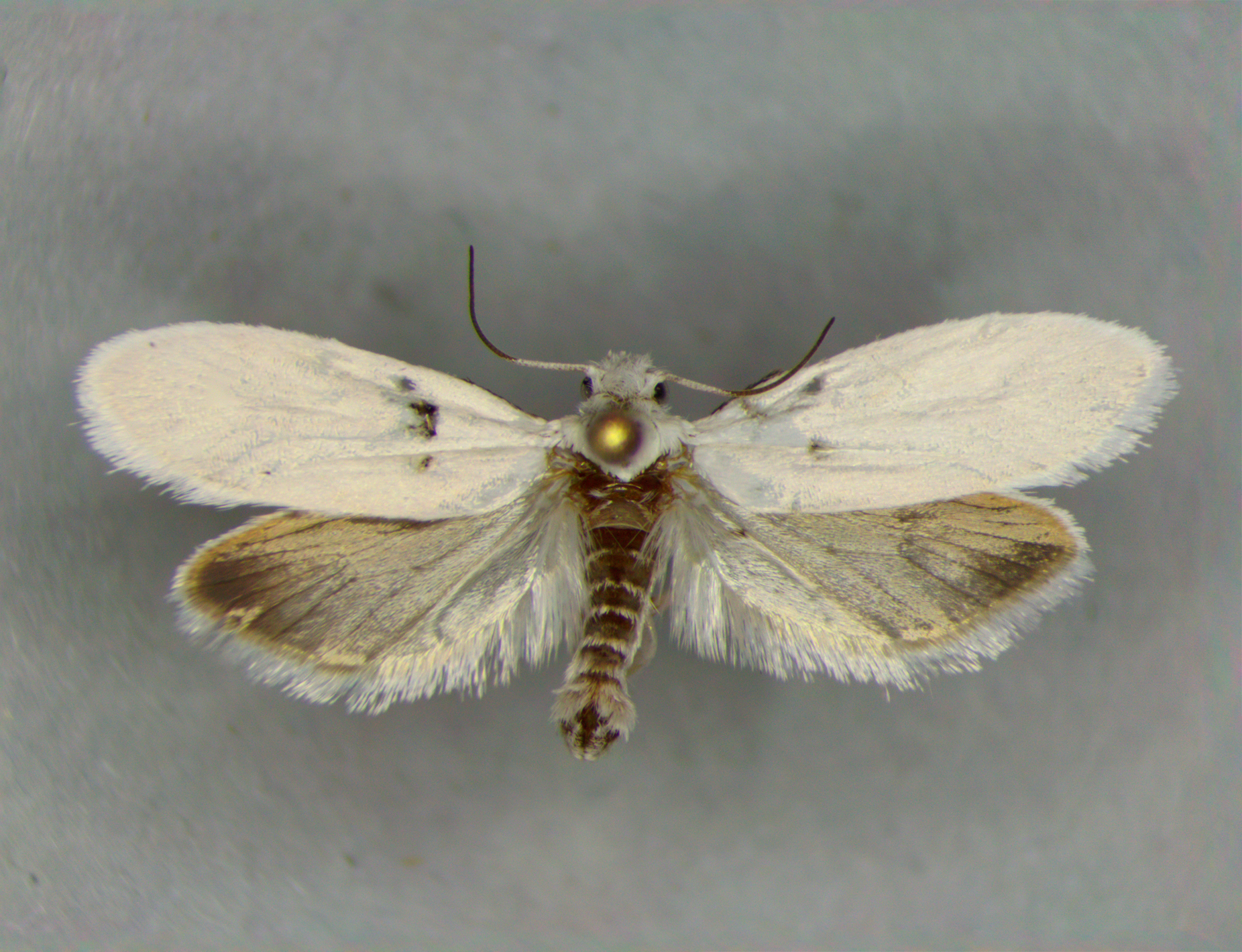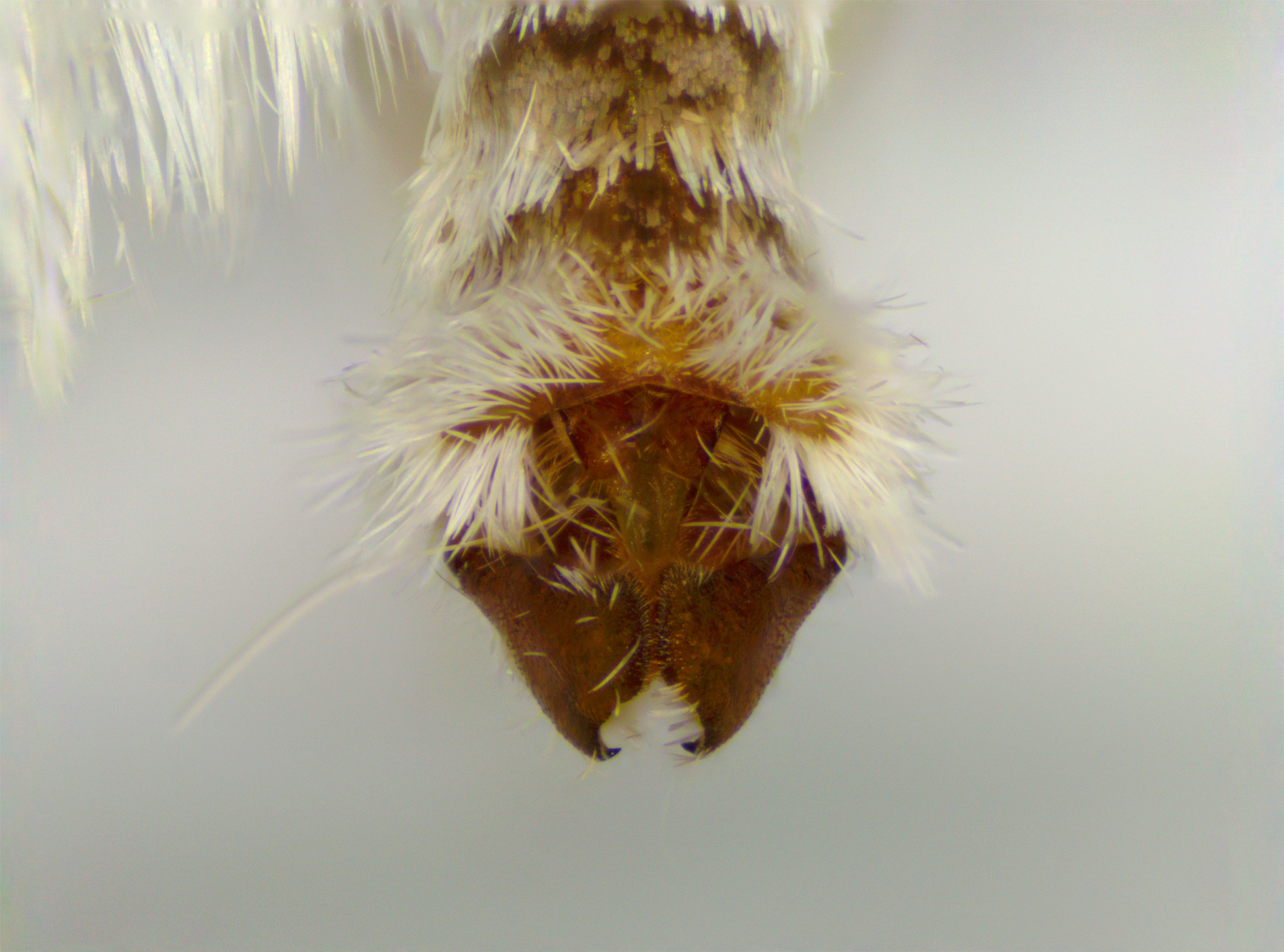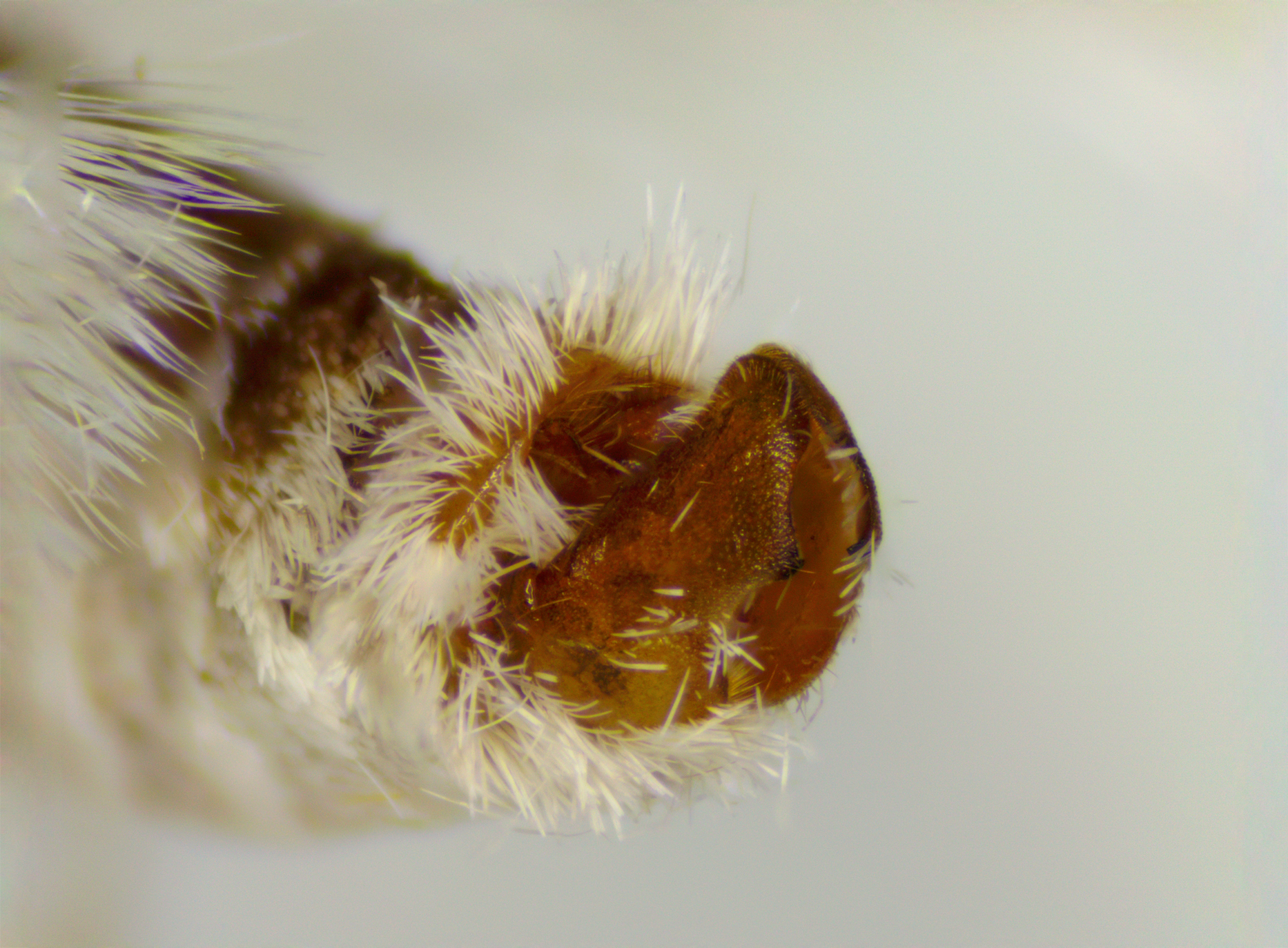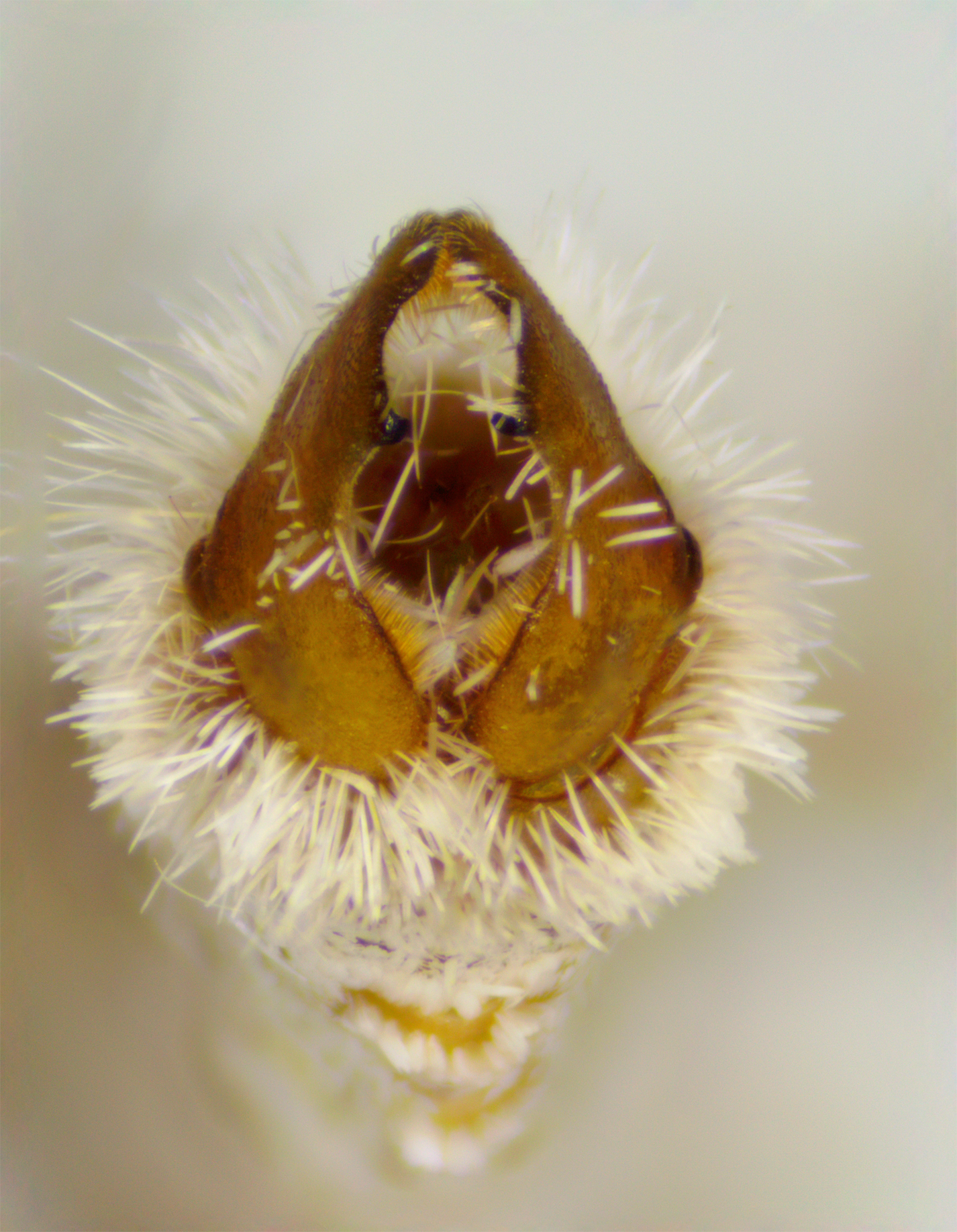Map Snapshot


1 Record
Status
Three Yucca moth species are known to occur in Maryland and can co-occur in multiple life stages within the same yucca plant. Females of only Eastern Yucca Pollinator Moth pollinate yucca plants, while females of Tegeticula intermedius and Prodoxus decipiens do not pollinate them. Males of all three species also do not pollinate them. All three species belong to the family Prodoxidae, which includes moth species that specialize on other plants besides yucca.
Description
Distinguishing live adults of the three species is usually not possible on sight or in photo records due to their external similarity and overlapping size distributions. Identifications of adults usually must remain at the group of three species. However, close-up, detailed images of the face and of the genitalia at the end of the abdomen (the latter usually unhelpfully covered by the wings in typical resting posture) can sometimes permit identification to two or even just one of the three species without collecting the specimen, as follows: A patch of tan scales in the discal cell of the otherwise immaculate white forewing, rarely extended to a larger region of the wing, occurs only in Tegeticula intermedius. However, many adults of this species have immaculate, white forewings without a tan patch, indistinguishable from the forewings of both Eastern Yucca Pollinator Moth and Prodoxus decipiens. A collected, pale yellow, pollen ball on the face of the moth indicates a pollination habit. This habit is present in only Eastern Yucca Pollinator Moth females. Such pollen balls are easily recognizable from views of the face and the side of the head. The absence of a pollen ball provides no useful diagnostic information. The presence of a long, coilable maxillary tentacle, arising from the joint of the basal two segments of the maxillary palpus, indicates the ability to grasp collected pollen balls and pollinate yucca plants, an ability that only Eastern Yucca Pollinator Moth females have. This tentacle is usually longer than the maxillary palpus and about as long as the galea (one of the two branches of the bifurcated proboscis). Males of all three species, females of Tegeticula intermedius and Prodoxus decipiens, and even some females of Eastern Yucca Polinator Moth have a reduced, vestigial, or absent tentacle. A close-up view of the face is necessary to recognize the state of the tentacle. Males of Prodoxus decipiens have longer valvae, about 1/4 of the forewing length, while males of the two Tegeticula species have shorter valvae, about 1/6 of the forewing length. This character can distinguish the two genera and, because only one species of Prodoxus co-occurs, can allow single-species identification of Prodoxus decipiens when the valvae are long. This character is usually covered by the wings in typical resting posture, making it rarely useful for live adults. Outside these scenarios, collected specimens are needed for identification.
Seasonality Snapshot
Source: Wikipedia
| Tegeticula intermedia | |
|---|---|
| Scientific classification | |
| Domain: | Eukaryota |
| Kingdom: | Animalia |
| Phylum: | Arthropoda |
| Class: | Insecta |
| Order: | Lepidoptera |
| Family: | Prodoxidae |
| Genus: | Tegeticula |
| Species: | T. intermedia
|
| Binomial name | |
| Tegeticula intermedia (Riley, 1881)
| |
| Synonyms | |
| |
Tegeticula intermedia is a moth of the family Prodoxidae. Along with other moth species, it is commonly known as a yucca moth. T. intermedia lives in North America, particularly the United States. The moth resides in the southwest, the Great Plains, the Southeast, and mid-Atlantic. It also has been found much farther north in regions of Canada like Ontario and Alberta. There are also notable populations present in New Mexico. Their habitats are diverse and vary in terms of climate, landscape, and other factors. The moth lives in sand dunes, forests (pine, pinyon, oak), glades, grassland, desert, and forests from the East Coast to the Southwest.[1] Yucca moths have developed a strong mutualism with the yucca plant, such that both depend on each other for survival.[2] The yucca moths and yucca plants have coevolved over millions of years.[3] However, Tegeticula intermedia differs from most yucca moths in that it exhibits cheating behavior by laying eggs without pollinating the yucca plant.[4]
Geographic range
[edit]T. intermedia primarily lives within the United States in the Southwest and Great Plains. However, it also has managed to maintain populations in the Southeast, including Florida, Georgia, and Virginia. It has additionally been found in Ontario and Alberta, Canada.[1]
The latest research suggests that T. intermedia originated from the Southwestern region of the United States, approximately located in present New Mexico. It then followed the yucca plant as it propagated eastward and into the south, particularly in Florida. The sister species to T. intermedia, Tegeticula cassandra, also exhibits cheating behavior in pollination and is restricted to the Southeastern United States. This led some scientists to believe that T. intermedia originated from this region, known as the "out-of-Florida hypothesis." However, recent mtDNA analysis suggests that the species did in fact originate in the West.[5]
Habitat
[edit]Yucca moths such as T. intermedia tend to live where their partner yucca plants do.[4] T. intermedia has been found to reside in a diverse array of environments including shrub deserts, coastal dunes, prairies, forests (pine and oak), and glades. This moth has an approximate vertical distribution from 0-1400m.[6]
Food resources
[edit]Caterpillar
[edit]
Larvae feed on a variety of plants within the yucca genus, depending on the region of the population. Some host species include Yucca filamentosa, Y. arkansana, and Y. flaccida.[1]
Larvae feed on yucca seeds within the fruit. Since there is an abundance of seeds within the fruit, the larva does not impinge too heavily upon the health of the yucca plant or compete too strongly with other pollinator species of yucca moths.[7] These seeds are the only known food source to the yucca moth larvae. The larvae of T. intermedia superficially crawl towards the ovary so they can burrow past the wall and commence feeding upon the developing seeds. They then escape from the flower, falling to the ground to burrow and cocoon.[8]
Adult
[edit]Adults have such short lifespans that they do not need to eat to achieve their reproductive goals. Although they do have mouth parts or tentacles, these are used for collecting pollen than for feeding.[7]
Parental care
[edit]Host plant selection for egg laying
[edit]The host yucca plant regulates the number of eggs laid by selectively abscessing flowers that are overburdened with eggs. The plant selects which flowers to abscess by assessing its weight due to the excess of eggs and by recognizing severe ovule damage due to excessive oviposition. In T. intermedia, the moth avoids ovipositing into the ovule directly. Thus, the plant does not perceive ovule damage, and will not abort the flower.[4]
Oviposition
[edit]Although most yucca moths deposit their eggs in the ovule of the flower, Tegeticula employs different methods of laying eggs. T. intermedia employs superficial oviposition, meaning that the yucca moth lays its eggs very slightly beneath the plant tissue, so as not to damage the yucca ovule. This strategy allows the moth to bypass the yucca plant's regulation of the number of eggs it hosts, leading to exploitation of the plant.[4] Oviposition takes place in the fruit of the yucca.[8]
Life cycle
[edit]Egg
[edit]Yucca moths' mate in the spring when the yucca flowers are in bloom. They then mate on the yucca flower, usually in the evening when the flower will be open. Then, the female moth will lay eggs in the wall of the fruit of the yucca, typically around 6- to 20-day-old fruits.[8] T. intermedia is unique in that it will superficially oviposit eggs one at a time so as to deceive the yucca plant.
Caterpillar
[edit]Once laid, the larvae will hatch quickly in only a few days' time. During early instars the larvae feed inside the fruit on the developing seeds. Later in their development, the matured instars leave the fruit, preferably after a rainstorm or during wet conditions to make escape easier.
Pupa
[edit]The larvae fall to the ground, burying themselves in a cocoon one to two dozen centimeters below ground during pupation.
Adult
[edit]The adult moths will emerge in the following spring to restart the life cycle.[9][7]
Protective behavior
[edit]T. intermedia is a predominantly white colored insect. Mild color variation occurs in different regions. The white color allows the moth to blend in with the yucca flower, camouflaging it from predators.[7]
Genetic hybridization
[edit]Hybridization is when two different species or genetically different varieties of the same species are able to breed and produce offspring together. The offspring may have limited reproductive capability.[10] T. intermedia has successfully been able to mate with a similar moth, Tegeticula cassandra. Both have incredibly similar superficial ovipositor and aedeagus physiology. However, T. intermedia has not been found to have hybridized with any species with a locule ovipositor. Research suggests that it is thus the similarity in ovipositor that allows two different species to hybridize.[4]
Physiology
[edit]T. intermedia has a modest wingspan of around 25 mm. The fore wings can occasionally have a slight tan color, but the body of the moth is predominately white. The hind wings are a soft, light grey and brown color. These moths tend to be lighter in more southern populations. Female moths have special tentacles as mouth parts (although it does not eat as an adult) which it uses to scrape pollen from a yucca anther into a relatively large, sticky ball that can be as big as 10% of her body mass.[1][9][2][3]
Olfaction
[edit]Female yucca moths use their antennae to sense if a flower has already been visited, and presumably oviposited on, by another female by detecting trace pheromones left behind. If detected, the female leaves and finds another flower that hopefully has not been pollinated yet.[2][3]
Parasitism
[edit]With plants
[edit]Yucca moths get their name for the intense, obligate mutualism they share with the yucca genus that has evolved over millions of years. The yucca moth is the only insect capable of pollinating the yucca plant. Likewise, the yucca plant is the only biological resource that sustains the moth. Both are so deeply interdependent on each other for survival that in most cases one local population extinction event of either the plant or moth would lead to an extinction of the complementary species.[6]
However, Tegeticula intermedia is a cheater species of yucca moth that parasitizes the yucca plant. It has evolved to superficially oviposit to avoid detection by the yucca that would allow it to lay many eggs without inducing flower abortion. The key trait of this species is that it lays eggs without pollinating the yucca. It enjoys the benefits of reproducing without the costs of aiding yucca reproduction at the expense of the host.[8]
References
[edit]- ^ a b c d "Tegeticula intermedia". tolweb.org. Retrieved 2017-10-04.
- ^ a b c "Yucca Moths". www.fs.fed.us. Retrieved 2017-10-03.
- ^ a b c Pellmyr, Olle, and Krenn, Harald W. (January 30, 2002). "Origin of a complex key innovation in an obligate insect–plant mutualism". PNAS. 99 (8): 5498–502. Bibcode:2002PNAS...99.5498P. doi:10.1073/pnas.072588699. PMC 122798. PMID 11960006.
{{cite journal}}: CS1 maint: multiple names: authors list (link) - ^ a b c d e Althoff, D. M. (2014). "Shift in Egg-Laying Strategy to Avoid Plant Defense Leads to Reproductive Isolation in Mutualistic and Cheating Yucca Moths". Evolution. 68 (1): 301–307. doi:10.1111/evo.12279. PMID 24117334.
- ^ Segraves, Kari A., and Pellmyr, Olle and Harrison, R. (October 2004). "Testing the Out-Of-Florida Hypothesis on the Origin of Cheating in the Yucca Yucca Moth Mutualism". Evolution. 58 (10): 2266–2279. doi:10.1111/j.0014-3820.2004.tb01602.x. PMID 15562689. S2CID 33882816.
{{cite journal}}: CS1 maint: multiple names: authors list (link) - ^ a b Rentsch, Jeremy (2013). "ECOLOGY AND EVOLUTION OF SOUTHEASTERN UNITED STATES YUCCA SPECIES" (PDF). University of Georgia.
- ^ a b c d Pellmyr, Olle (2003). "Yuccas, Yucca Moths, and Coevolution: A Review" (PDF). Annals of the Missouri Botanical Garden. 90 (1): 35–55. doi:10.2307/3298524. JSTOR 3298524.
- ^ a b c d Marr, Deborah L.; Brock, Marcus T.; Pellmyr, Olle (2001-08-01). "Coexistence of mutualists and antagonists: exploring the impact of cheaters on the yucca – yucca moth mutualism". Oecologia. 128 (3): 454–463. Bibcode:2001Oecol.128..454M. doi:10.1007/s004420100669. hdl:2022/24397. ISSN 0029-8549. PMID 24549915. S2CID 6432027.
- ^ a b "The Yucca and its Moth". The Prairie Ecologist. 2010-12-09. Retrieved 2017-10-04.
- ^ "Hybridization, Plant – Biology Encyclopedia – body, human, process, animal, different, chromosomes, used, types". www.biologyreference.com. Retrieved 2017-12-01.
External links
[edit]- http://tolweb.org/Tegeticula_intermedia/12474 (includes pictures of species and range map)



